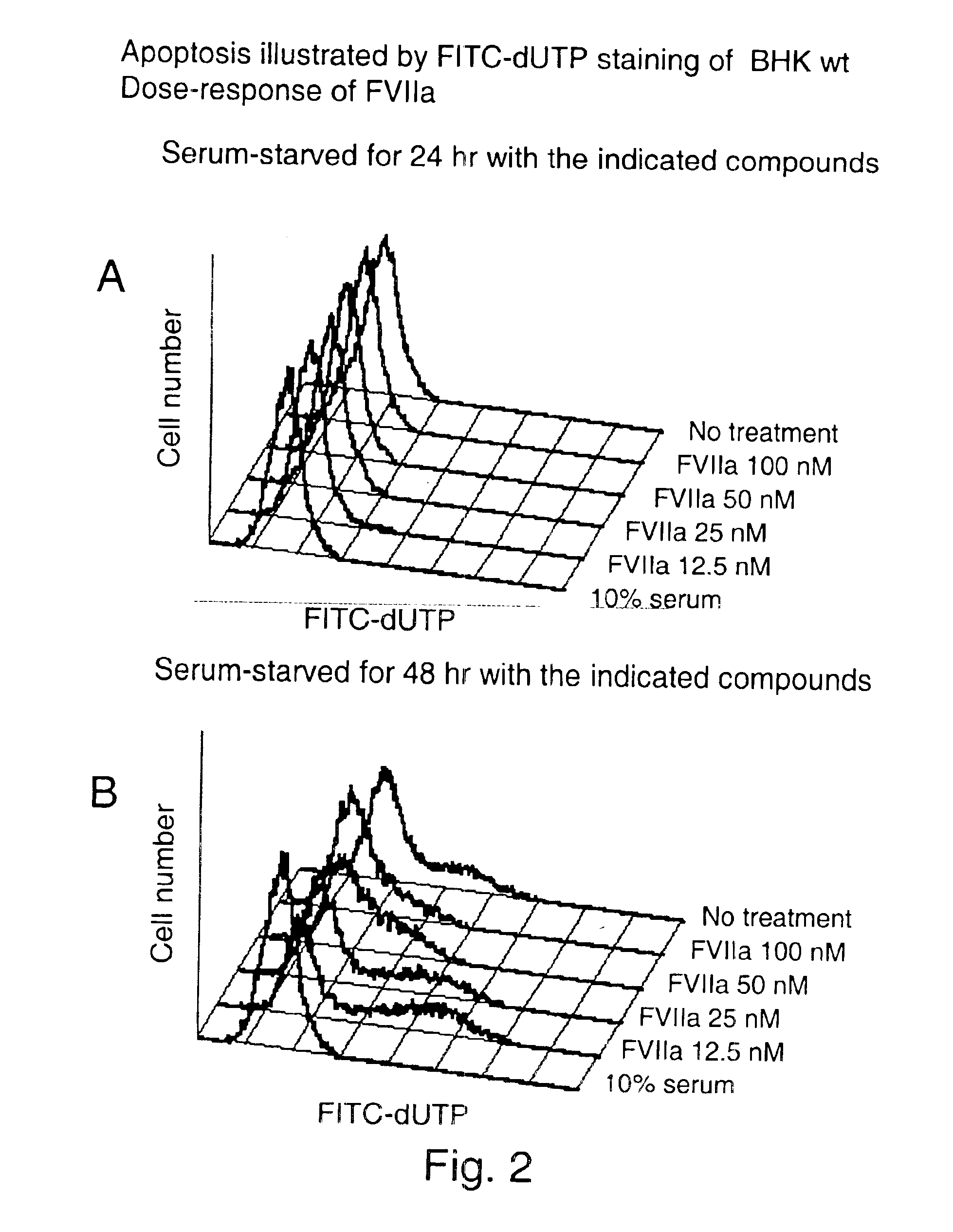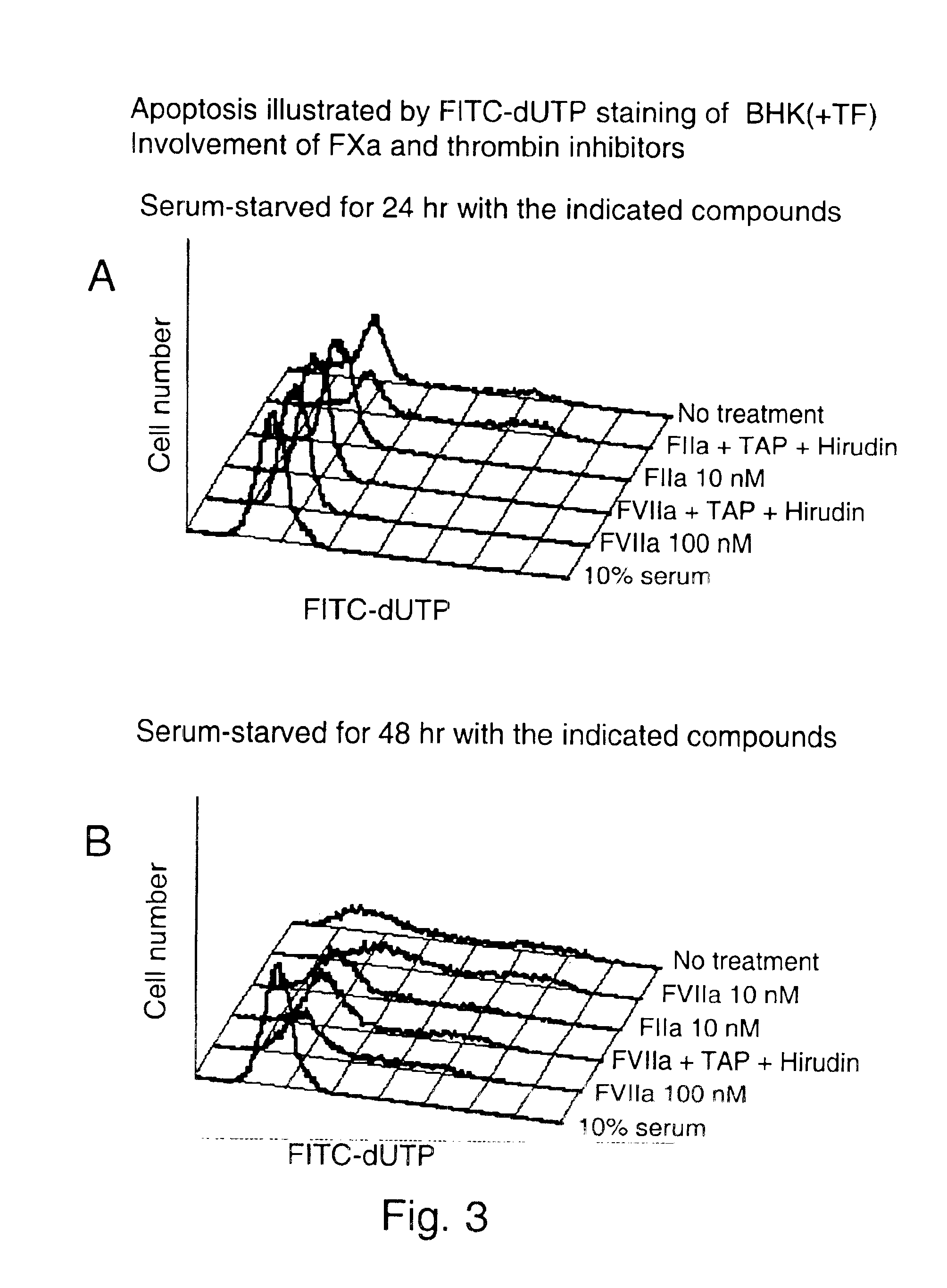Use of tissue factor agonist or tissue factor antagonist for treatment of conditions related to apoptosis
a tissue factor and apoptosis technology, applied in the direction of peptides, drug compositions, peptides, etc., can solve the problems of unrepaired nerve cell damage, unclear how tf contributes to these biological processes, and loss of function due to damaged nerve cells
- Summary
- Abstract
- Description
- Claims
- Application Information
AI Technical Summary
Problems solved by technology
Method used
Image
Examples
example 1
Preparation of FVII
Human purified factor VIIa suitable for use in the present invention is preferably made by DNA recombinant technology, e.g. as described by Hagen et al., Proc.Natl.Acad.Sci. USA 83: 2412-2416, 1986 or as described in European Patent No. 200.421 (ZymoGenetics). Factor VIIa produced by recombinant technology may be authentic factor VIIa or a more or less modified factor VIIa provided that such factor VIIa has substantially the same biological activity for blood coagulation as authentic factor VIIa. Such modified factor VIIa may be produced by modifying the nucleic acid sequence encoding factor VII either by altering the amino acid codons or by removal of some of the amino acid codons in the nucleic acid encoding the natural FVII by known means, e.g. by site-specific mutagenesis.
Factor VII may also be produced by the methods described by Broze and Majerus, J.Biol.Chem. 255 (4): 1242-1247, 1980 and Hedner and Kisiel, J.Clin.Invest. 71: 1836-1841, 1983. These methods y...
example 2
Preparation of FVIIai
Modified factor VII suitable for use in the present invention is made, e.g. as described in International Publications Nos. 92 / 15686, 94 / 27631, 96 / 12800 and 97 / 47651 ZymoGenetics / Novo Nordisk).
example 3
To investigate the effect of FVIIa on BHK(+TF) and BHK wt cell survival, apoptosis of cells was induced by serum-starvation for 24 hr and 48 hr. Apoptosis was detected by flow cytometry after Terminal deoxynucleotidyl-transferase dUTP Nick End Labeling (TUNEL). One of the later steps in apoptosis is DNA fragmentation, a process which results from the activation of endonucleases during the apoptotic program. The nucleases degrade the higher order chromatin structure into fragments of approximately 300 kb and subsequently into smaller DNA pieces about 50 bp length. In the TUNEL assay (APO-BRDU from Pharmingen) TdT catalyses a template-independent addition of bromolated deoxyuridine triphosphates (Br-dUTP) to the 3′-hydroxyl termini of double- and single-stranded DNA in paraformaldehyde and ethanol fixed cells. After incorporation these sites are identified by flow cytometric means by staining the cells with a FITC-labeled anti-BrdU mAb. To follow cell-cycle progress, the cells are in ...
PUM
| Property | Measurement | Unit |
|---|---|---|
| Level | aaaaa | aaaaa |
Abstract
Description
Claims
Application Information
 Login to View More
Login to View More - R&D
- Intellectual Property
- Life Sciences
- Materials
- Tech Scout
- Unparalleled Data Quality
- Higher Quality Content
- 60% Fewer Hallucinations
Browse by: Latest US Patents, China's latest patents, Technical Efficacy Thesaurus, Application Domain, Technology Topic, Popular Technical Reports.
© 2025 PatSnap. All rights reserved.Legal|Privacy policy|Modern Slavery Act Transparency Statement|Sitemap|About US| Contact US: help@patsnap.com



